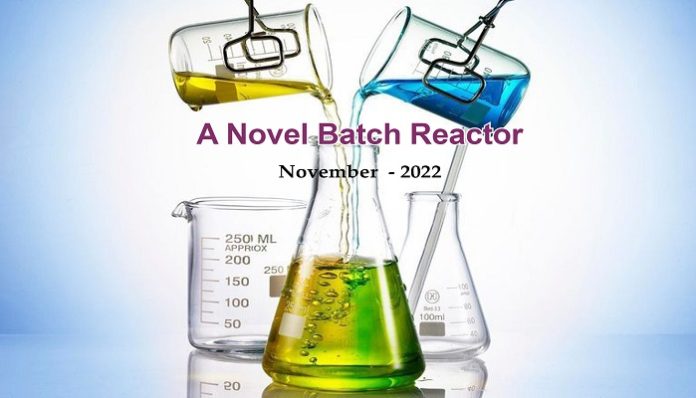Batch reactor, the workhorse of the specialty chemicals industry, has remained the same in the last two centuries. But a major disruptor has recently emerged. We take a peek at this novel reactor which offers significant improvements in heat transfer.
Continuous processes have many advantages over batch processes. They are more energy efficient and also utilise resources more efficiently because of significantly lower downtimes. They are also safer because of lower work-in-process inventory. Yet, batch processes dominate the chemical industry, especially in the specialty chemicals segment. Batch processes are ideal for manufacturing multiple products on a campaign basis. Batch processes offer better product quality and improved traceability, which are important for approvals from regulatory bodies. Batch processes are very versatile and widely used for manufacturing small volume, high value products.
Batch Reactor
The batch reactor is at the heart of specialty chemicals industry. It is the workhorse which cooks various ingredients together to miraculously conjure up a new product with beneficial properties. Modern chemical industry is at least 200 years old, but the humble batch reactor has hardly changed from the early days. It continues to be a cylindrical vessel with an agitator to stir the contents and equipped with a jacket or coil to supply or remove heat during the course of the chemical reaction. Many new products have been developed over the course of the last two centuries, but the batch reactor has essentially remained the same.
Heat Transfer
One of the perennial challenges in a batch reactor is heat transfer. Many reactions are exothermic and the heat needs to be removed as rapidly as possible. Inadequate dissipation of heat results in a temperature increase with serious consequences. It will lead to the formation of undesirable side products and this not only reduces the yield, but also increases the purification cost. A more serious consequence is the possibility of a runaway reaction which comes with the accompanying risk of loss of containment and explosion. Heat transfer coefficients in jackets and limpet coils are poor and the geometry of the reactor limits the heat transfer area that can be provided. The problem is more acute in glass-lined reactors, because of the additional resistance of the reactor wall to heat transfer. The reactor contents have to be heated up to the reaction temperature and finally cooled after the reaction has concluded. The heat transfer area controls the time required for heating and cooling and eventually the overall batch time. A longer batch time means higher capital investment.
Multipurpose Batch Plant
The specialty chemicals industry uses a multipurpose batch plant to manufacture several chemicals. At any point of time, different sets of reactors and other equipment are engaged in production of different chemicals. The batch cycles of these processes are also different and dictated by the chemistry that is unique to the particular process. The reactors and other equipment are not optimised for any particular process and thus there is a high degree of flexibility. The same set of equipment can be used to manufacture a different product at another time to cater to the market demands. Standardisation, rather than optimisation, is the key principle of multipurpose batch plants. The different processes in a multipurpose batch plant operate independent of each other, but they share a common infrastructure that provides the requisite heating and cooling. The heating / cooling infrastructure is not optimised with a view to confer a high level of flexibility to the overall plant. It usually has margins to cater to the introduction of new product lines. Inefficiencies are thus inbuilt by design into batch plants. Energy management is usually given short shrift by the specialty chemicals business because the processes are comparatively less energy intensive as compared to those in commodity sectors. But this is rapidly changing as focus sharpens on reducing the carbon footprint. There is a need for innovative solutions.
Novel Design
An engineering company from Scotland, Process Technology Strategic Consultancy (PTSC) has developed a novel batch reactor that seeks to address the heat transfer problem head on. The design employs a slew of proprietary features to boost the heat flux to 4 times more than what can be realised in a standard glass lined reactor. The key element in this design is the baffle into which heat transfer facilities are incorporated. Internal channels are provided within the baffles through which a thermic fluid is circulated. The thermic fluid removes the “Delta T” restriction between the heating/cooling media and the process fluid and further increases the heat flux. The design uses a proprietary Thermal Control Unit (TCU) for managing the heat transfer with precise control of temperature. The significantly higher heat flux would improve productivity of the reactor by substantially reducing the heating and cooling times and thereby the batch cycle. The precise temperature control during operation and the rapid cooling is also expected to confer salutary benefits on product quality.
Testing
PTSC has carried out extensive testing of the novel reactor. The tests were carried out in a facility constructed by Kobelco Eco Solutions, Japan and included an equivalently sized conventional reactor so that comparisons could be drawn up. The reported outcomes are more than encouraging. The heating and cooling rates achieved in the novel reactor are 4 times more than what was realised in the conventional design. The product temperature was brought down by 5 degrees C in 300 seconds against 810 seconds in a conventional reactor. The primary energy consumption in the new design was half of that required for the conventional design. The results demonstrate increase in both productivity and energy efficiency.
Patent
Scientists from the University of Aberdeen and Glasgow Caledonian University have collaborated in the scale up and development of this reactor which has the objective of improving the energy efficiency. The development took a little more than 4 years and involved extensive thermodynamic and mixing modelling. The design has already received a patent in USA. Patents have been filed in Europe, China, Japan and India. The company’s management says that the results of the large scale testing have exceeded their expectations and they believe the reactor has the potential to be a major disruptor in the chemical industry.
Epilogue
Information about the PTSC reactor has been gathered from published sources. Some additional has been obtained through private correspondence with the management of PTSC. The information presented here is to generate general awareness without any conflict of interest.
Readers’ responses may be sent to:
k.sahasranaman@gmail.com or
chemindigest@gmail.com

































